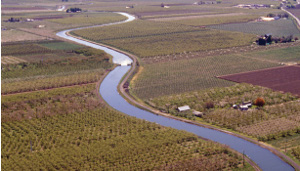Western Droughts Push Water Rights to Forefront
You can’t trademark natural resources, but ownership of them is increasingly becoming an issue as those resources become scarce. In fact, the question of ownership over water rights has become a knock-down fight. Water shortages have been an issue in the western states in the U.S. for well over 100 years and officials could foresee even back then that water was limited. However, particularly as the population has grown out west, demands for water have far exceeded even what was anticipated back then.
When are water rights likely to affect you? In short, any time you want to withdraw new water. Whether you’re drilling a new personal well, a farmer irrigating your crops, or using large amounts of water for a fracking project, you’re going to need to secure water rights. Any time you want to use large amounts of water, you have to offset the use somewhere else to make sure water budget neutrality is established.

|
|
The Yakima River basin supports a range of water uses, from recreation to farming to drinking water. Here, a canal that flows from the Yakima River irrigates apple and pear orchards. Source: Brian Prechtel / Agricultural Research Service |
Water rights are a complicated issue. To ensure that there’s enough water to meet current and future needs—particularly in the case of water shortages—anyone withdrawing water for a new purpose has to ensure an offset somewhere else. Every state in the West has their own water rights division, each of which has slightly different rules.
“You can’t get mitigation credits for having water just anywhere, they must be suitable for your withdrawal area and offset your specific withdrawal right there,” said Joye Redfield-Wilder, public information office with Washington’s Department of Ecology. “We have sustainability maps for water rights that show whether you can proceed [with a water withdrawal], if more information might be needed or if that water right isn’t suitable if your land/parcel is in that area.”
“Our water rights here in the Yakima area were established in May 1905, so that’s the cut-off date,” said Steve Lathrop, Washington attorney and owner of a private water bank. The 1905 date establishes the status of junior versus senior users, but because few people still own the same properties as they did in 1905, they are likely unaware of their ownership rights.”
“Yakama Indian and U.S. Bureau of Reclamation (USBR) rights and senior user rights established between 1855 and 1905 trump all others when water is short or official drought is declared. The USBR claimed all unappropriated water rights in 1905. So, all users after that are considered junior users and rely on excess water in the system,” said Redfield-Wilder. This concept of junior versus senior rights is one that most people don’t understand and only encounter during water shortages.
“Say you built a house in 1952 and had a well. Imagine you get a knock on the door saying that you’re considered a junior user and have to stop using water. How are you going to react to that?” said Lathrop. “There’s always the threat that, in a short water year, junior users would have to stop using water, but so far it hasn’t happened yet.”
However, it may happen. According to the Agriculture Department’s Office of the Chief Economist, the droughts in the West in the past three years have been the worst since the 1950s and have had substantial economic impact in terms of crop losses. Cities in the southwest have also been selling their water, even during drought periods, to allow fracking operations to continue. Scientists know the western states have been vulnerable to drought for thousands of years, largely because the region gets so little precipitation, which is why careful management of water resources is essential.
At the present, only the western and southwestern states have water rights laws. However, other states may be facing the issue in the future due to expanding fracking operations. Michigan developed a Water Assessment Withdrawal Tool in 2010 to examine the impact of withdrawing large amounts of water. Michigan has an abundance of water, but hasn’t seen such large withdrawals before. It is unknown how many other states with more water may face shortages due to withdrawals for fracking.
The first step for water withdrawals in most states is to issue permits. “Any time a well is drilled deeper than 30 feet, we require a permit,” said Jim Goddard, well drilling specialist at the Utah Division of Water Rights. “Of course, it’s okay if someone is drilling a well to lower the water table or to check the water profile, but we do a review process to approve any new water use.”
A major complication with water rights is that domestic water rights sometimes differ from county or district water rights. There’s only so much water to go around, and each side wants to keep as much of it as possible. When someone makes a claim on the water, whose rights determine who should get the water? It’s a battle that is often extremely fierce and heated. Some cases have gone all the way to state Supreme Courts. In fact, Lathrop said that one such case has been in adjudication since 1977.
Water rights are challenged in two main situations: when requesting new water and during droughts. Roslyn, Wash., found this out the hard way when irrigators sought a court order against Roslyn for withdrawing water out of priority. As a result, there is now a permanent court order shutting off Roslyn’s water whenever future rationing of irrigation rights occurs.
However, Roslyn is not the only municipality that has made these kinds of mistakes, and in most cases it’s an innocent error due to unclear understanding of who owns the rights and how much water exists for use. “In an over-allocated basin, some people are using water that isn’t actually available,” Lathrop said. “The point of the permits is to make sure that we have actual water, not just on paper.”
Sometimes, people want to withdraw water and their permit is denied because there isn’t enough water available. In this circumstance, private water banks like the one Lathrop owns can offer water rights for purchase. Not surprisingly, purchasing water rights from a water bank can be expensive, depending on the amount of water needed, the location and the extent of the water limits in the region.
Securing water rights can be a major problem for drillers, particularly in the case of new construction. “I tell you, water rights can be kind of a pain in my rear,” said Phillip Merrill, owner of Merrill Drilling in Oregon. “The challenge is that it’s getting more and more difficult to get water rights. I’ve been doing this for 15 years and it’s only getting worse.”
One of the most frustrating aspects for drillers when it comes to getting water rights is the delay it presents. “Having to get water rights really delays construction. In Oregon, it can take up to a year and a half to get water rights. Of course, we can’t begin until we get approval,” Merrill said.
The western states have seen as much as 25 percent population growth in the past decade, and that’s not expected to slow down any time soon. New construction will need to continue to accommodate the influx of residents. Fracking is also expected to continue, to meet rising demands for oil. At this point, the focus is turning toward ways to preserve existing water supplies while looking for more.
“In the last legislative session, the state pledged $100 million to move an integrated plan forward,” said Redfield-Wilder. “The plan calls for conservation, ground and surface water storage, habitat restoration and fish passage in an effort to meet the basin’s long term needs. Tapping into an additional 50,000 acre-feet to cover domestic use is also part of that plan, and so is market-based reallocation of water in the short term through water banking.”
In the meantime, convincing the public to take the issue seriously is a challenge that government agencies have to continue to take on. “We’ve been out of allocated water since 1905, but we’re still trying to make everybody understand it. It’s not something you can boil down to a simple picture to explain why it’s important,” said Lathrop.
Looking for a reprint of this article?
From high-res PDFs to custom plaques, order your copy today!



